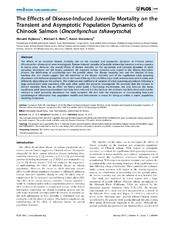| dc.creator | Fujiwara, Masami | |
| dc.creator | Mohr, Michael S. | |
| dc.creator | Greenberg, Aaron | |
| dc.date.accessioned | 2014-09-04T21:49:39Z | |
| dc.date.available | 2014-09-04T21:49:39Z | |
| dc.date.issued | 2014-01-10 | |
| dc.identifier.citation | Fujiwara M, Mohr MS, Greenberg A (2014) The Effects of Disease-Induced Juvenile Mortality on the Transient and Asymptotic Population Dynamics of Chinook Salmon (Oncorhynchus tshawytscha). PLoS ONE 9(1): e85464. doi: 10.1371/journal.pone.0085464 | en |
| dc.identifier.other | http://dx.doi.org/10.1371/journal.pone.0085464 | |
| dc.identifier.uri | https://hdl.handle.net/1969.1/152158 | |
| dc.description.abstract | The effects of an increased disease mortality rate on the transient and asymptotic dynamics of Chinook salmon (Oncorhynchus tshawytscha) were investigated. Disease-induced mortality of juvenile salmon has become a serious concern in recent years. However, the overall effects of disease mortality on the asymptotic and transient dynamics of adult spawning abundance are still largely unknown. We explored various scenarios with regard to the density-dependent process, the distribution of survivorship over the juvenile phase, the disease mortality rate, and the infusion of stray hatchery fish. Our results suggest that the sensitivity to the disease mortality rate of the equilibrium adult spawning abundance and resilience (asymptotic return rate toward this equilibrium following a small perturbation) varied widely and differently depending on the scenario. The resilience and coefficient of variation of adult spawning abundance following a large perturbation were consistent with each other under the scenarios investigated. We conclude that the increase in disease mortality likely has an effect on fishery yield under a fluctuating environment, not only because the mean equilibrium adult spawning abundance has likely been reduced, but also because the resilience has likely decreased and the variance in adult spawning abundance has likely increased. We also infer the importance of incorporating finer-scale spatiotemporal information into population models and demonstrate a means for doing so within a matrix population modeling framework. | en |
| dc.description.sponsorship | The open access fee for this work was funded through the Texas A&M University Open Access to Knowledge (OAK) Fund. | en |
| dc.language.iso | en_US | |
| dc.publisher | PLOS | |
| dc.rights | Attribution 3.0 United States | en |
| dc.rights.uri | http://creativecommons.org/licenses/by/3.0/us/ | |
| dc.title | The Effects of Disease-Induced Juvenile Mortality on the Transient and Asymptotic Population Dynamics of Chinook Salmon (Oncorhynchus tshawytscha) | en |
| dc.type | Article | en |
| local.department | Wildlife and Fisheries Sciences | en |
| dc.rights.requestable | false | en |



